
 Sculpture News at SculptSite.com
Sculpture News at SculptSite.com
Peggy Walton Packard Sculptor and Singer |
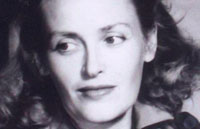 |
| TimesColonist.com BY ROBERT AMOS Sculptor-singer had can-do styleArtists and poets admired Peggy Walton Packard's skill, but fame eluded her Peggy Walton Packard, who recently died at the age of 95, was precociously talented as a sculptor and as a singer. Though fame never came her way, groups of artists, sculptors, poets and musicians gathered around her, inspired by her skill and her spirit, her candour and her can-do attitude. I was one of many who entered by the garden gate into a magical world that she shared with her younger sister Amy, who is now 92. Peggy was one of five children of Helen and Geoffrey Walton. Geoffrey had immigrated to Winnipeg from Barbados in 1898, arriving in Victoria in 1912 where he founded the Sidney Lumber Company. Peggy was born in 1914 and grew up on her family's farm high on the Lansdowne slope overlooking the Olympics. The family belonged to St. Luke's Anglican Church, and Peggy attended St. Margaret's School, city high schools and, for two years, Victoria College at Craigdarroch. Her journals record the joys and heartaches of youth amid her circle of friends, whether walking home after choir practice or sharing a soda at Terry's Restaurant. In the late 1930s she studied art with Ina Uhthoff where, in a frigid studio, she was offered a bucket of clay. "I stayed there until I was congealed with cold," the sculptor told me. "Life has never been the same since." Shortly after, she moved to Philadelphia to study at the Pennsylvania Academy of Fine Art with sculptor Paul Manship. About that time, a friend suggested that she attend the local audition for New York's Juilliard School of Music and, to her surprise, she won a scholarship for singing. In 1947 she married an intense and committed young sculptor, David Packard, and, after five years of study in Philadelphia and New York, she returned to Victoria. He was 19 and she was 32. Together they had two children, Wendy and Christopher, but the marriage didn't work out and David left in 1951. Peggy and the children stayed on, and she became a fixture in the musical life of Victoria, singing in operas, concerts and musicals. Her production of Amahl and the Night Visitors introduced the 12-year old Timothy Vernon to Victoria audiences. Vernon, now artistic director of Pacific Opera Victoria, eventually married her daughter Wendy. Peggy supported her youngsters by teaching art and drawing portraits in pastel. Soon, recognizing the talent for portraiture that her close friend Myfanwy Pavelic displayed, Peggy decided to concentrate on sculpture. The family acreage was eventually reduced and the old home demolished. She lived on in what had been the barn. In her studio within the stone walls of its foundation she modelled and moulded hundreds of figures in clay, plaster and cement. Some are almost life-sized, and they surprise and enchant visitors who come across them in the rambling terraced garden. Smaller figures inhab-it every nook and cranny of the delightful arts-and-crafts loft in which the sisters continued to live. Amy, who never married, was to her sister a beloved "tower of strength." Peggy Packard's sculptures are unique, robust and finely crafted. In the early days there was no money for civic art in Victoria, and when money eventually did come, her work was perhaps too loving and sincere, and frankly old-fashioned, to be considered. Her one public commission, a bust of the Queen to commemorate the royal visit of 1959, should have opened the door to fame, but the experience was unsatisfactory for the artist. The municipalities, which had commissioned the work, quibbled about who should pay and eventually reneged. The sculpture was the subject of a "Pennies for Peggy" campaign, and the pittance due to the artist was eventually paid by Stuart Keate and the Times. To add injury to insult, the work was repeatedly vandalized. Subsequently, Peggy steered clear of publicly commissioned work. Still, Peggy continued according to her passion and her principles. She privately created a tender evocation of The Snow Goose, a story by Paul Gallico. Her thrilling study of the fleeing Erlkonig, inspired by Goethe's poem and Schubert's song, races through her garden. Devoted students and a few private shows kept the wolf from the door but, surprisingly, she never had a major gallery exhibition. When I interviewed her in 1999 she seemed skeptical of my praise. It was only later, when I borrowed from her a large statue of a loving couple as the centrepiece of an art show at the Maltwood Museum in 2007, that she knew I truly valued her work. In her final year, Peggy was hospitalized and a stream of visitors arrived to keep her company. Folk dancers, francophones, horticulturalists, family and friends brought the intellectual stimulus she craved until the end. Sensing the end was near, a few years ago Peggy brought her favourite sculptures in from the garden for a final touch-up. She said she was frustrated that she hadn't accomplished more, though I assured her that she had been truly prolific. Now her work is done, and I believe the impact and influence of her sculpture will properly begin. As I wrote in my first interview with her, "a visit to the sculpture garden of Peggy Walton Packard is a journey to a better world." Mary Josephine (Peggy) Walton Packard was born Oct. 13, 1914, in Victoria and died Sept. 12 in Victoria. A celebration of Walton Packard's life will be held at the McPherson Playhouse from 3 to 5 p.m. on Friday, Nov. 12. |
 I was taken by the pristine beauty of Peggy Walton Packard. I sadly did not know her. I wanted to bring her life to our readers, and thanks to Robert Amos I was able to. May she rest in peace knowing her life's work is valued. Following the images below is a more detailed account of the Queen Elizabeth II sculpture and photos. |
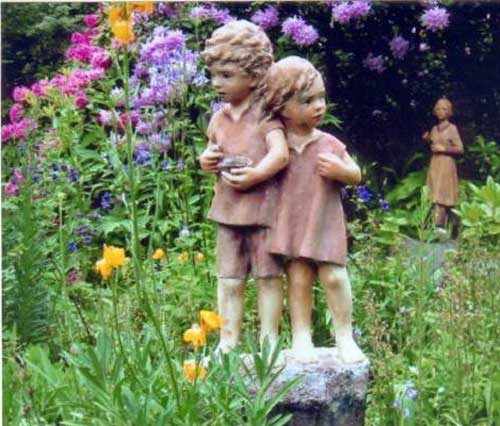 "Hansel and Gretel" by Peggy Walton Packard |
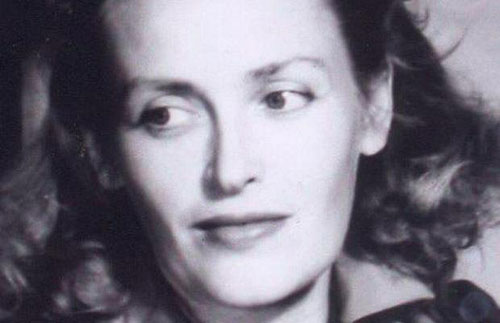 Peggy Walton Packard |
The short and eventful life of the first Royal BustBy Janis Ringuette |
She survived kidnapping and the loss of two noses, but not decapitation. After her head was knocked off and thrown into the Inner Harbour in December, 1960, the concrete bust of Queen Elizabeth II was removed from Beacon Hill Park. The statue lasted one drama-filled year. The bust was created to commemorate the June, 1959 royal visit. The area's four municipalities agreed to share costs of the event on a per capita basis, including local sculptor Peggy Walton Packard's modest fee of $350. By the time the concrete statue was completed six months later, Esquimalt and Oak Bay didn't want to pay their share. The statue price had escalated to $1,000, including landscaping. Money wasn't the only complaint. Many thought concrete was too easily damaged. Not everyone liked the way the 750 pound statue looked, either. It was described as "a concrete head mounted on a seven-foot pedestal." The City of Victoria took delivery of the statue in January, 1960, but did not put it on public display. "It has been stored ignominiously at the Garbally public works yard," the Victoria Daily Colonist reported. Under heavy media pressure, officials moved the statue to the lobby of City Hall. When the city delayed paying Packard her commission, the Victoria Daily Times launched a tongue-in-cheek "Pennies for Peggy" campaign with the headlines: "If the City won't pay her, let us do it" and "Make the Pennies Pour for Peggy." Donated pennies would be pushed to City Hall in a wheelbarrow. City officials were not amused. Acting Mayor Mooney quickly announced Packard could pick up her cheque on Friday, February 19, but the penny campaign continued with a new headline: "Peggy Bank Goes For Landscaping." The statue was stolen from City Hall Thursday evening. Nine pennies were left in the statue's place. A team effort was needed to carry the 750 pound, one-piece, seven-foot statue from the front hall, along the south corridor and out the unlocked Pandora Avenue door. The kidnapping was apparently a university prank. Packard visited the scene of the crime the next morning. "This is the crowning touch," she said, wiping away tears of laughter. "Now we'll get the landscaping and no queen. I think it's very funny." Acting Mayor Mooney wasn't laughing. He blamed the Times "continuous sniping." Ald. Arthur Dowell wasn't laughing either. He called the kidnapping "a college prank, a mockery, a tragedy and an insult to the Queen." The statue was recovered in Esquimalt three days later, uninjured except for a shallow groove chipped out of one shoulder. Worried city officials moved it into a private office. "The bust of Queen Elizabeth is under lock and key...surrounded by a cloak of security that would do credit to the wildest of TV spy thrillers," the Daily Colonist reported. "City hall staff members and police received orders not to talk to anyone about the bust--especially not to reporters." On Monday, March 21, 1960, the statue was installed "quietly and without ceremony" on a concrete semi-circle in front of a 7.6 metre (25 foot) wall with stone facing constructed in Beacon Hill Park. According to a Daily Times report, it was an area "on which attractive beds could be laid out, with a pleasant, sloping background of natural pines." That description left out a key detail. The bust was placed at the back of a parking lot. The Queen stood at the south edge of the Park's main parking lot on Circle Drive with the Burns Monument distantly visible to the north. Queen Elizabeth and Robbie Burns were to gaze forever at one another over parked cars and passing Circle Drive traffic. The photo on the right shows the Queen's view of the Burns Monument (the white pedestal in the background). In less than a month, the Daily Times reported: "A piece of concrete about two inches long, one and a half inches wide was chipped out of the right nostril." The Queen's cheek and neck were chipped next, then the nose. "Final mortification was the disappearance of the head, later recovered from the bottom of the Inner Harbour." The Daily Times commissioned a replacement bust made of bronze. Ottawa resident Arnold Price, the only Canadian sculptor with experience in bronze, used the original mold created by Peggy Packard. The completed bust, anchored at the southeast corner of Queen's Lake on Circle Drive, was formally presented to the city by publisher Stuart Keate on August 5, 1962. The newspaper glowingly described the "gold-toned" bust mounted on a "white stone plinth over a bed of Scottish heather and evergreen shrubs and clumps of fragrant lavender. Behind was a majestic weeping willow, an ornamental pond and a rich profusion of roses. In the vicinity are a cricket pitch and the World's Tallest Totem Pole..." The location was definitely superior to the parking lot. The second bust has enjoyed a quiet life, though it was knocked flat in August, 1965. Reached by phone recently, sculptor Peggy Packard recalled another incident: "An X was scratched on the Queen's forehead, perhaps with a diamond ring. It is hard to scratch bronze. I had to do some covering up on that. You can still see it if you look closely." This 1994 photo shows Packard cleaning the bronze bust before the Queen arrived to open the Commonwealth Games. Remembering the pranks and vandalism of the 1960s, Packard said, "It was awful. It seemed the university students were attacking the Queen and indirectly attacking me, too." She never accepted another public art commission. Even now, she worries about drawing attention to the bust. The rock wall constructed for the concrete bust remains in the parking lot west of the petting farm. The statue's half-circle base is now a neglected planter, although a beautiful black marble mounted on it still proclaims: "Queen Elizabeth II. To Commemorate Royal Visit July 17, 1959." For 43 years, the handsome bronze bust of Queen Elizabeth II has stood next to Queen's Lake, picturesquely framed by shrubs. The only hint of past indignities is the faint X visible on her forehead. |
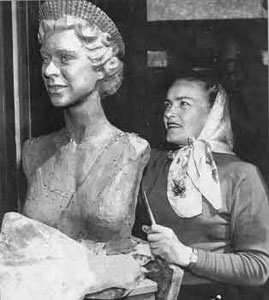 |
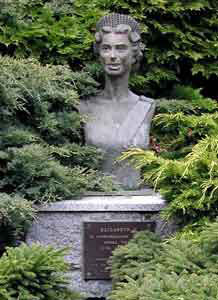 |
| Peggy Walton Packard - Sculpture Queen Elizabeth II | |
More Sculpture News ....
Submit your SCULPTURE NEWS.
It's easy, just send us an e-mail
(click on Submit News in the left menu) with your pertinent information along with images, we'll take care of the rest. Sculpture makes our world a much better place in so many ways!
SculptSite.com, along with Sculptors and their creative genius all helping to bring the beauty and message of Sculpture to a hurried world.

